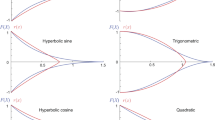Abstract
Transient potentials in dendritic trees can be calculated by approximating the dendrite by a set of connected cylinders. The profiles for the currents and potentials in the whole system can then be obtained by imposing the proper boundary conditions and calculating these profiles along each individual cylinder. An elegant implementation of this method has been described by Holmes (1986), and is based on the Laplace transform of the cable equation. By calculating the currents and potentials only at the ends of the cylinders, the whole system of connected cylinders can be described by a set of n equations, where n denotes the number of internal and external nodes (points of connection and endpoints of the cylinders). The present study shows that the set of equations can be formulated by a simple vector equation which is essentially a generalization of Ohm's law for the whole system. The current and potential n-vectors are coupled by a n × n conductance matrix whose structure immediately reflects the connectivity pattern of the connected cylinders. The vector equation accounts for conductances, associated with driving potentials, which may be local or distributed over the membrane. It is shown that the vector equation can easily be adapted for the calculation of transients over a period in which stepwise changes in system parameters have occurred. In this adaptation it is assumed that the initial conditions for the potential profiles at the start of a new period after a stepwise change can be approximated by steady-state solutions. The vector representation of the Laplace-transformed equations is attractive because of its simplicity and because the structure of the conductance matrix directly corresponds to the connectivity pattern of the dendritic tree. Therefore it will facilitate the automatic generation of the equations once the geometry of the branching structure is known.
Similar content being viewed by others
References
Bartsch HJ (1985) Taschenbuch Mathematischer Formeln. Harri Deutsch, Thun Frankfurt/Main
Holmes WR (1986) A continuous cable method for determining the transient potential in passive dendritic trees of known geometry. Biol Cybern 55:115–124
Jack JJB, Noble D, Tsien RW (1975) Electric current flow in excitable cells, Oxford University Press, Oxford
RallW (1959) Branching dendritic trees and motoneuron membrane resistivity. Exp Neurol 1:491–527
Rall W (1977) Core conductor theory and cable properties of neurons, In: Kandel ER (ed) Cellular biology of neurons, American Physiological Society, Bethesda (Handbook of Physiology, Sect. 1/I, 39–97)
Sherman AH (1977) Algorithm 533: NSPIV, a fortran subroutine for sparse gaussian elimination with partial pivoting. ACM Trans Math Software 4:391–398
Stehfest H (1970a) Algorithm 368: numerical inversion of Laplace transforms. Comm ACM 13:47–48
Stehfest H (1970b) Remark on algorithm 368. Comm ACM 13:624
Author information
Authors and Affiliations
Rights and permissions
About this article
Cite this article
van Pelt, J. A simple vector implementation of the Laplace-transformed cable equations in passive dendritic trees. Biol. Cybern. 68, 15–21 (1992). https://doi.org/10.1007/BF00203133
Received:
Accepted:
Issue Date:
DOI: https://doi.org/10.1007/BF00203133




